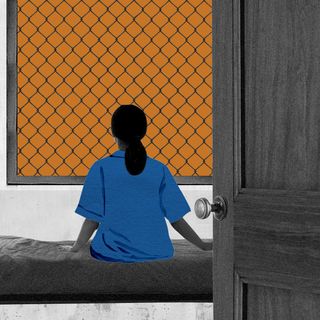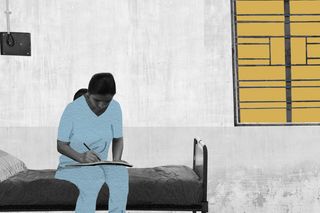
How Deinstitutionalizing Mental Health Can Restore Dignity to Women with Mental Illness
Furled by user-survivor activists, a new movement seeks to make institutions the last resort and instead address mental health needs through community care and support.

The Kilpauk Institute of Mental Health outpatient department is a liminal space, somewhere between institutionalization and ‘reintegration.’ A Hot Breads bakery attached to the hospital serves as the workplace to Devi and Jaya two formerly institutionalized women. The institute has now provided them with separate living spaces and a job at the bakery. They share similar histories: severe depression, abandonment by their families, and a lack of options to exit the system completely.
Mental health activists have criticized India’s mental health institutions as a space where many women struggle to have autonomy over their bodies and their treatment. But even for those who are ultimately declared fit for discharge from the institute, things rarely get easier. Their options — which institutions sometimes facilitate — range from shelter homes, reinstitutionalization to family reunification. While these can restore some autonomy to women, the freedom to decide where to go and how to live can be conditional upon whether or not womens’ families take them back. Often, like with Devi and Jaya, they don’t.
Both women are “recovered” now, in that they can work, look after themselves, and express their needs and desires well. They have greater autonomy than their counterparts in the in-patient department. But there are confines to how they can express their agency. Both have a tone of gratitude for the institution, resignation, and hurt for what they went through to get to a place of relative dignity and agency.
Although they are now happy here by their own account, their happiness is underscored by regret and self-blame.
“Me being here is not anyone’s mistake; I spoiled my life by not listening to anyone,” Jaya says. “I am 45 years old, and my life won’t come back. I will just go on this way… it makes me cry when I talk about it.” She pauses to wipe her tears.
Devi’s family’s abandonment also hurts her deeply. While she suffered a relapse and underwent electroconvulsive therapy for the fourth time, her son visited her, but she did not offer to take her back.
As Jasmine Kalha, from the Centre for Mental Health Law and Policy, points out: “Once labeled, you forever stay that way, there is no un-labeling mechanism that can happen. No one can then certify you as ‘normal’ or ‘sane’ or whatever those mental health conditions mean for us.”
Hospitals like Kilpauk Institute have made inroads in incorporating strategies that would restore as much autonomy as possible to women like Devi and Jaya. But this is conditional: relapses could once again lead to women losing hard-won gains.
“Sometimes, when we’re sick, we have to be treated like children. Doctors tell us that the treatments are for our good,” they add.
Although Devi can work now, she is bound by fear and undermining her agency to the institution. But this doesn’t have to be the only way. An approach in which relapses or intense episodes treats women with short hospitalizations is an alternative that many advocate for, just like with any illness. But isn’t widely considered valid for a condition that affects the mind and, therefore, “capacity.”
Related on The Swaddle:
It is in this context that user-survivors of institutions began the effort to deinstitutionalize. This means that people with mental illnesses can negotiate terms of care from the beginning instead of being reintegrated from a place of no independence.
For Debayani Sen, from Iswar Sankalpa, a Kolkata-based organization that works with homeless people with psychosocial needs, deinstitutionalization is about centering people’s choice and dignity rather than saving them.
The deinstitutionalization movement in mental health began around the 1950s. Fuelled by user-survivor activists, it aims to make institutions the last resort and instead address mental health needs through community care and support. Importantly, deinstitutionalization allows for people to come together in spaces of shared identity and support one another. This is in response to how marginalized people especially are often pathologized due to their social circumstances.
“We need to acknowledge identity as a site where distress and conflict can occur, due to lack of resources, discrimination, historical disenfranchisement; and that these very sites of identity are where individuals seek solidarity, form support networks, engage in advocacy and shared dissent,” a report by the Mariwala Health Initiative report states.
The Mariwala Health Initiative report also shows how neoliberalism — or the ideology of individualizing all aspects of life in terms of personal gains and losses — masks the structural nature of mental health. In other words, this ideology in a medical context ignores how mental health factors someone’s social privileges. Instead, it treats people as decontextualized individuals who are objectively sick. This aligns with the institutional model of alleviating symptoms in individual patients rather than using a broader, community-based model of care.
“We don’t think women can do anything, and that’s what guides the ethos of the institution,” says Ratnaboli Ray, the founder of Anjali in West Bengal, an organization aimed at deinstitutionalizing mental health.
To this end, organizations like Iswar Sankalpa and Anjali arrange drop-in centers for people to access of their own accord. Centers include bathing and food facilities as well as therapy and vocational training sessions.
“There is care and support in institutions too — but after a few days, we realize that the institutionalization is taking place within that person,” says Laboni Roy, also from Iswar Sankalpa. “In institutions, ownership of one’s own life completely goes away, and the person becomes like a puppet.”
According to Roy, rather than improving a person’s capacity, however defined, institutions in India often run the risk of paralyzing someone’s capacity and free will. In a setting where disobedience is pathologized as a symptom or as aggression, “the person does whatever we tell them to, but there is no initiative or life within,” Roy adds.
What institutes deem as “improvement” in symptoms might often be stagnation. “From a clinical point of view, the person does not create “trouble.” But the person is also inactive. The person is not troubling, but the person is also not growing.”
This is not to say that people don’t get better inside institutions. Deinstitutionalization, however, functions on the belief that hospitalization should never continue indefinitely and against people’s will.
The law has only recently caught up with this understanding. The Mental Healthcare Act of 2017, considered by mental health practitioners to be a progressive piece of legislation, allows people to make “advance directives.” Informally known as a “living will,” an advance directive empowers a mentally ill person to determine how they want to be treated for their illness and nominate a representative for themselves.
Related on The Swaddle:
We Need to Reframe Mental Health as a Social Justice Issue, Not a Personal Problem
The provision is significant in terms of restoring autonomy to people for whom it is already undermined structurally. For marginalized people especially, unlike with other ailments, external entities step in to decide what happens to an individual’s body, mind, mobility, and freedom.
The institutional model is also challenged by how many women in these institutions have histories of homelessness. Women who “appear” mentally ill are brought to mental health facilities by the police — in itself a telling sign of the age-old link between “madness” and criminality. This further intersects with concerns about women’s shame and dignity, where living on the streets is not seen within the ambit of women’s capability but through a protectionist lens. When women are “rescued” from the streets and taken to restrictive mental health institutions, how much do they benefit?
Despite having symptoms, many women “have marvelous skills to negotiate with chai wallahs, local small shops that sell food.” Adding the caveat that she is not glorifying life on the streets, Ray suggests that living on the streets for some women is an “exercise of autonomy or agency.” But often, it is seen as deviance from how women’s roles are understood, leading to their being taken away without their consent.
The problem arises from institutions “not adhering to the dignity of taking the risk,” Ray says. Deinstitutionalization, then, removes the protectionist gaze with which society and the state look at mentally ill women. And so it is that organizations like Anjali and Iswar Sankalpa offer facilities for the wandering population to avail of their own free will. Importantly, they offer nightly shelters for women who may otherwise be vulnerable to violence on the streets.
There is an implicit mechanism of consent at play. By not forcibly taking women into shelters and facilities but providing them as options, deinstitutional models of mental healthcare ask questions about what people want, how they want to be treated and allow them to make decisions about their lives with dignity. In a society where ill women are often moved from the family institution to the institution of the mental health facility, this is radical.
In essence: deinstitutionalization is to give people autonomy over their health, recognizing that being mentally healthy means and looks like different things, depending on where one comes from.
Mental health thus also goes beyond institutions; it is systemic. “The state has failed the family and, therefore, the families have failed their women,” Dr. K V Kishor Kumar, who works with abandoned women diagnosed with mental illnesses, told The BBC.
Deinstitutionalization is, therefore, as much a social justice issue involving dismantling structural oppression as it is about enabling access to support and community care. As Ratnaboli Ray puts it: “Deinstitutionalization is a state of mind as well.”
Indeed, institutionalization invokes specific images about dilapidated psychiatric hospitals. But, as Ray points out, it is hardly ever about brick-and-mortar infrastructure. It is about breaking down the norms and ties constraining how we think, feel, speak and act.
“It does not mean another house or home. It means access: access to justice, access to care, access to employment, access to housing and most importantly, access to relationships, pleasure, sexuality.”
Ultimately, deinstitutionalizing mental health means looking inward at the values and norms we uphold. What are the hierarchies we maintain, which resources are we monopolizing, and at whose expense?
As an unnamed woman in the in-patient department at Kilpauk reminded me, those of us inside and outside mental health institutions are not all that different.
If we could only see behind the high guarded walls of institutions, we would find people who fought battles too large for them to take on and who paid the price for the rest of society’s apathy. The question that the presence of institutions prompts is not what mental illness is but who is defined and held captive by it.
This article is the second of a two-part piece on women in mental health institutions in India.
Rohitha Naraharisetty is a Senior Associate Editor at The Swaddle. She writes about the intersection of gender, caste, social movements, and pop culture. She can be found on Instagram at @rohitha_97 or on Twitter at @romimacaronii.
Related


What’s With the Mysterious ‘Havana Syndrome’ Affecting U.S. Diplomats?
